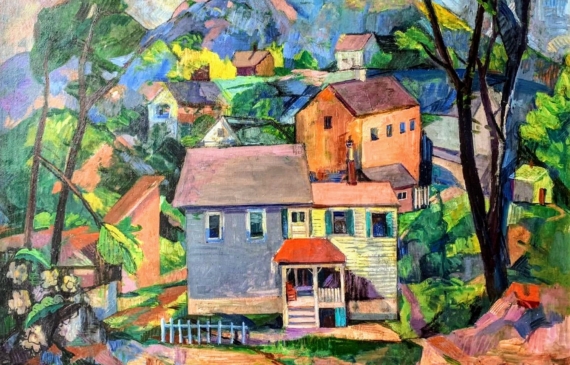
Kyōhei Inukai (American, 1913-1985)
Untitled (New England Landscape), c. 1930
Oil on canvas, 32 H. x 40 ¼ W. inches
Signed lower right: Inukai
Kyōhei Inukai (Earle Goodenow) lived in New York in the 1930s and studied painting at the Art Students League. He held his first one-man show in 1934, at the California Arts Club, of which his mother was a member. The next year, he contributed an oil painting, “Spring, Montauk” to a show at the Louis Comfort Tiffany Foundation in New York. His work was also displayed in shows at Pittsburgh’s Carnegie Institute and the Corcoran Gallery in Washington DC. Meanwhile, in order to support himself, he worked in advertising and commercial art.
In 1947, Inukai traveled to France and held a one-man show at the Galérie de l’Elysée in Paris. He was the first American artist since the Liberation to have a show in a Paris gallery. Anne Green, writing in Town & Country remarked, “He is an excellent craftsman, and I was particularly impressed by his nudes.” A reviewer for the French journal Combat remarked in May 1947 that he had not “affirmed his [individual] personality in the face of the numerous fads that threaten every contemporary artist; but certain [aspects] of his paintings raise hopes that he will do so one day.”
In the years that followed, Inukai went on to write and illustrate a series of popular children’s books, concentrating on animals like his brother Girard. It is an open question whether Inukai’s mixed ancestry affected his stories, as many of which involve individuals dealing with being different. For instance, his book The Peevish Penguin (1955) tells the story of a penguin who is disturbed that he cannot fly, and tries to think up alternate plans. The Last Camel (1968) tells the story of a grumpy dromedary with a poor sense of direction. Among his most creative and whimsical stories was The Owl Who Hated the Dark (1969).
While he continuously published children’s books under the name Earle Goodnow, after his father’s death (whose name he shared), the artist started producing work under his given name of Kyōhei Inukai. Using his birth name, the artist participated in shows in the White House Rotating Exhibition, the U.S. Embassy in Tel Aviv, and the USIA Print Exhibition at the 1970 Osaka World’s Fair in Japan. In 1967, he had a show at the Goodenow Gallery (presumably family-run) in New York. In 1970, he had a solo painting and sculpture show at the Spectrum Gallery in Manhattan’s Soho district. Ten years later he put on a second solo show at the Suzuki Gallery.
Inukai worked in a variety of styles, from abstract expressionism to constructivism, and was known for his use of bright colors. Inukai also became known for his abstract sculptures, especially in aluminum and steel. Inukai’s painting is included in such collections as those of the Albright-Knox Museum, Buffalo; the Portland Museum of Fine Art, Oregon; the Rose Art Museum, Waltham, Massachusetts; and the Wichita University Museum of Fine Art. His sculptures can be found in such places as Knoxville, Tennessee; the Monmouth Mall in Eatontown, NJ; and Riverside Mall in Chicago. Earle Goodenow/Kyōhei Inukai died in February 1985, shortly before the centenary of his father and namesake.